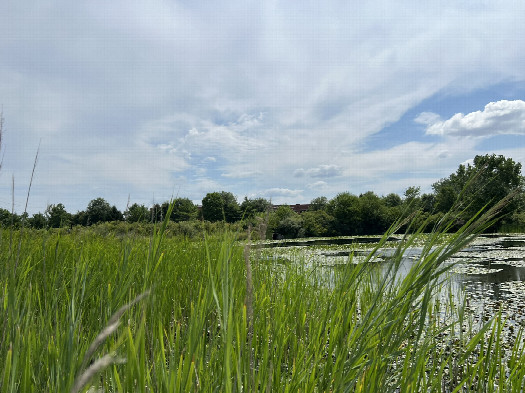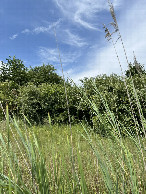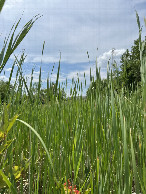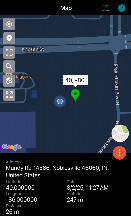|
United States : Indiana
3.2 miles (5.1 km) S of Noblesville, Hamilton, IN, USA
Approx. altitude: 246 m
(807 ft)
([?] maps: Google MapQuest OpenStreetMap topo aerial ConfluenceNavigator)
Antipode: 40°S 94°E
Accuracy: 31 m (101 ft)
Quality: good
Click on any of the images for the full-sized picture.
| 40°N 86°W (visit #13) |
 (visited by Jacob W and Jack S) 02-Aug-2025 -- Jack and I realized we would both be in Indianapolis for a brief time on the first Saturday of August, so like any good reunion of friends, we made sure to sneak a confluence into our few hours of time together. As luck would have it, the northern portions of the Indianapolis metro are home to a somewhat easily accessible confluence–40°N 86°W lies in the idyllic and rapidly expanding Hamilton County suburb of Noblesville, just to the north of its border with neighboring Fishers. The point actually lies within a small retention pond between the Prairie Lakes at Noblesville shopping center (home of Jaggers, the counter serve burger joint that several previous visitors had discussed) and the Community Health Pavilion medical complex, but getting to within 100 meters would be a cakewalk, as both these facilities enjoy ample parking and the well-groomed landscaping typical of upscale suburbia. The attempt to get as close as possible, however, would prove to be more challenging. During the brief meetup, we first stopped by a bustling local farmer's market at the heart of Fishers, IN, a nearby affluent suburb of Indianapolis that has ballooned in population within the past few decades as with many northern Indy suburbs. In an attempt to match the aura of its polished neighbor, Carmel, which boasts meticulously maintained pedestrian trails surrounded by mixed-use high-density developments galore, Fisher’s downtown has likewise experienced a dramatic transformation within the past decade. From a quick peek at Google Street View, the modest municipal complex, surrounded by open fields as recently as 2013 and so unremarkable that even the underwhelming fictional town of Pawnee, Indiana from the hit comedy TV series Parks and Recreation would find it lacking, is now encircled by towering multi-story apartments, contemporary mixed-use developments, and a former railroad track repurposed as a spacious pedestrian and biking trail. Further north by 40°N 86°W, this explosive development takes the form of more traditional suburban sprawl; since the initial visit in 1996, the surrounding area has transformed from a bucolic landscape resembling any stretch of the rural Midwest to big-box stores, chain restaurants, and medical centers wrapped with ample parking and nestled beside a sprawling highway interchange. After leaving downtown Fishers, we had a short 10-minute drive north on IN-37 and east on 146th St before arriving at the Jaggers restaurant referenced in previous reports. Upon arrival, we were met with a staggering number of people waiting outside and in the drive-thru at the Dutch Bros across the parking lot. While Dutch Bros is an above-average coffee chain (on par with 7 Brew) that we have been familiar with in Oklahoma for years, this particular location was the sole Dutch Bros in the entire Indy metro, making it an understandably popular destination. This building and its associated uptick in nearby vehicular traffic is a new addition since the last report at this confluence in 2022, as this location had just opened within the last couple of months. Finding one of only a few spots available in the Jaggers lot, we set our eyes on the line of blue spruce trees demarcating the property's boundary; technically, the retention pond and confluence lie within a parcel owned by the Prairie Lakes apartment complex to the south. Spotting a narrow opening between the Jaggers parking lot and the Godby Home Furnishings store immediately to the south, we crawled our way into the marshy wetland adjacent to the retention pond where the confluence is located. Walking northeast along the western periphery of the pond, the vegetation transitioned from light, knee-deep graminoids and forbs to taller and thicker reeds that extended above our heads, which made it difficult for us to comfortably navigate around. They were certainly nothing like the sea of colossal wet corn stalks Gavin Roy experienced at 40°N 95°W about a week prior, but it was enough to be slightly disorienting. Additionally, the ground beneath us grew increasingly muddy as we approached the water’s edge. After some strategic maneuvering and using the thick reeds as a temporary bridge above the water, our best attempt without soaking our shoes was 26 m with an accuracy of 5 m. Admittedly, visiting during the peak of summer vegetation, especially during a period of average to slightly above-average precipitation, may not have been ideal. Thanks to a well-timed cold front that had swept through the area two days before, however, the weather was rather pleasant during our visit compared to the unrelenting barrage of heat and humidity that had plagued much of the region in the days prior. Arriving between 11 and 11:30 AM, temperatures were only ~70°F (21-22°C) with comfortable dewpoints in the low 60s (~17°C), light winds (<10 kts), and calm, partly cloudy skies. After the successful confluence visit, we rewarded ourselves with shakes from Jaggers. Interestingly, we found that Jaggers is a spinoff of another, more widely known Indiana-founded chain, Texas Roadhouse (“Indiana Roadhouse” clearly didn’t set the correct tone). The chain has haphazardly expanded to roughly 20 restaurants in four states (Indiana, Kentucky, North Carolina, and Texas), but the first location is right here at the confluence. Given its proximity to the confluence, we jokingly floated the idea of submitting the report from entirely within the Jaggers, but unfortunately, the building itself is just out of reach from the 100-meter threshold (the drive-thru kiosk, however, is approximately 70m away). The confluence is also in sight of the easternmost Pickleman’s Sandwiches, another regional chain (Missouri-founded) that we have become familiar with in our time in Oklahoma. While the confluence shakes at Jaggers were rewarding, we ate lunch at a nearby Skyline Chili, a unique regional chain that serves Cincinnati-style chili. Cincinnati "chili" is different from chili con carne and resembles more of a soupy pasta sauce with additions of cinnamon, nutmeg, and other Mediterranean spices (it originated from Greek immigrants). Its signature dishes, the "ways" (i.e. three-way, four-way, and five-way), are served with chili poured atop spaghetti and topped with a prodigious amount of shredded cheddar cheese. A native of the Cincy area, I was eager to enjoy one final Skyline meal before my annual months-long departure to the void of Oklahoma. Both of us got a four-way, which comes with spaghetti, chili, cheese, and your choice of either black beans or onions. Our final stop of the afternoon adventure was downtown Carmel: a utopia of spacious urban walking and biking trails; walkable, high-density multi-story mixed-use developments; beautifully integrated greenery; and eclectic yet elegant architecture (AKA probably a modern urban planner's dream, or a typical European town). All of this was made possible by the brains and vision of one man: Jim Brainard, longtime (7-term) Carmel mayor, who pioneered a wildly successful, sustainable, and people-centric development strategy that rejected the typical car-centric suburban framework of surface parking lots and cookie-cutter single-family homes (at least in its downtown). Beyond its downtown, Carmel is also known for replacing most of its traffic lights with roundabouts (over 150!), earning it the colloquial nickname “roundabout capital of the US.” Walking around Carmel and Fishers, I couldn’t help but notice the number of people wearing Pacers apparel. As a newfound Oklahoma resident and Oklahoma City Thunder fan, I was in enemy territory; earlier this summer, the Indianapolis Pacers and OKC Thunder of the National Basketball Association (NBA) fought in a grueling seven-game series to determine the winner of the NBA Finals, of which the Thunder emerged victorious in Game 7. Much to my surprise and mild disappointment, the Thunder shirt I was wearing didn’t draw much reaction beyond the occasional glancing look or passing stare. Having successfully clenched another confluence with a friend and explored the mildly amusing suburbs of Indy, it was an afternoon well spent before hitting the road west on I-70 and I-44 for a long-haul drive to Oklahoma. |
| All pictures |
| #1: Overview of the confluence facing the retention pond toward the east #2: Facing east toward the retention pond #3: Facing north, surrounded by reeds #4: Facing west, toward the row of trees #5: Facing south, toward the apartment complex #6: Screenshot of GPS app depicting nearest distance of 26m to confluence #7: Screenshot of GPS app depicting coordinates and accuracy ALL: All pictures on one page |
| Notes |
|
In a pond, about 50 yards from the lakeside. |







![Visit #12: [12-Aug-22] Visit #12: [12-Aug-22]](/us/in/n40w086v12/preview.jpg)
![Visit #11: [05-Oct-18] Visit #11: [05-Oct-18]](/us/in/n40w086v11/preview.jpg)
![Visit #10: [24-May-18] Visit #10: [24-May-18]](/us/in/n40w086v10/preview.jpg)
![Visit #9: [01-Apr-12] Visit #9: [01-Apr-12]](/us/in/n40w086v9/preview.jpg)
![Visit #8: [21-Dec-08] Visit #8: [21-Dec-08]](/us/in/n40w086v8/preview.jpg)
![Visit #7: [22-Jun-08] Visit #7: [22-Jun-08]](/us/in/n40w086v7/preview.jpg)
![Visit #6: [20-Jun-05] Visit #6: [20-Jun-05]](/us/in/n40w086v6/preview.jpg)
![Visit #5: [08-Jul-03] Visit #5: [08-Jul-03]](/us/in/n40w086v5/preview.jpg)
![Visit #4: [01-Sep-02] Visit #4: [01-Sep-02]](/us/in/n40w086v4/preview.jpg)
![Visit #3: [05-Jul-02] Visit #3: [05-Jul-02]](/us/in/n40w086v3/preview.jpg)
![Visit #2: [01-Apr-00] Visit #2: [01-Apr-00]](/us/in/n40w086v2/preview.jpg)
![Visit #1: [25-Dec-96] Visit #1: [25-Dec-96]](/us/in/n40w086/preview.jpg)